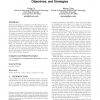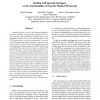270 search results - page 47 / 54 » Modeling of a Hybrid Ad Hoc Cellular Network System |
EURONGI
2006
Springer
14 years 2 days ago
2006
Springer
Wireless sensor networks (WSNs) pose challenges not present in classical distributed systems: resource limitations, high failure rates, and ad hoc deployment. The lossy nature of w...
CCS
2003
ACM
14 years 1 months ago
2003
ACM
Although the ability to model and infer Attacker Intent, Objectives and Strategies (AIOS) may dramatically advance the literature of risk assessment, harm prediction, and predicti...
DEXAW
2007
IEEE
14 years 10 days ago
2007
IEEE
A number of factors, such as the increasing popularity of wireless networks, the opportunities offered by 3G services, and the rapid proliferation of mobile devices, have stimulat...
INFORMS
1998
13 years 8 months ago
1998
High-level formalisms such as stochastic Petri nets can be used to model complex systems. Analysis of logical and numerical properties of these models often requires the generatio...
MOBIHOC
2009
ACM
14 years 9 months ago
2009
ACM
In this paper, we consider a non-saturated IEEE 802.11 based wireless network. We use a three-way fixed point to model the node behavior with Bernoulli packet arrivals and determi...


